| |

Local
History |
'Working
to preserve the rich heritage of the Temecula Valley' |




Biography
of Roy Morrissey |

The
Last Living Artist of the High Country Magazine written by Jeffery G. Harmon and Roy Morrissey Interview with Roy Morrissey, April 30, 2002 "The people there in Temecula were great people. They were all colorful and I liked them all." Roy Morrissey, April 30, 2002 |
"On
the 10th day of May, 1925, the quiet solitude in the little town of
Suisun, California was suddenly shattered by the wail of a newborn
infant - another man child had been added to the human race."
(Man of Many Colors by Bill Harker) Roy started his art career as a child. He would copy pictures of comics from the funny papers. As a teenager, he would stand in the corner of the Post Office, pretending to read a book. Actually he was quickly sketching people waiting in line. The war came and he went to serve his country. He was wounded. When he returned home, he couldn't do physical labor. He got his high school degree and went to the California College of Arts and Crafts. After he graduated, he went to work in San Francisco doing displays for J.C. Penny's Department Store. He was given an opportunity to take a position at the Walnut Creek store, but he turned it down. He wanted to do art. So he moved to Salt Lake City, Utah. There he found an artist on every corner. He had to find a way to make a living. He started doing three fold brochures for companies. The business grew into an ad art agency. A man with the local newspaper, asked to become Roy's business partner. They formed an Advertising Agency. Five years later the business partner died, and Roy sold his business. He returned to Southern California and took a teaching position at Palomar College where he taught for twelve years. This move brought him one step closer to meeting Ralph Love and falling in love with a small town called Temecula. Here are some of Roy's memories of his life in Temecula: I discovered Temecula in 1966. I met Ralph Love while both of us were displaying our paintings at a gallery in Lake San Marcos, CA. Ralph Love asked me to come and see him in Temecula at his old Art Shack. He said you can't miss it. You can see it from Highway 395. At that time I was living in Fallbrook and teaching art at Palomar College in San Marcos, CA. I decided to take a day off and go see Ralph. So I hopped onto my motorcycle for the half hour trip. When I arrived, sure enough, you could see that sign off of 395. The Art Shack was on Front Street just on one side of town. Let me say, if you have ever seen a shack, The Art Shack was a shack of all shacks. It looked like it was held together with chewing gum. When I pulled up along side the building the doors were shut, but in juxtaposition of the shack, the paintings in the windows were beautiful. Suddenly the door opened as I was about to leave and a lady with gray hair appeared and said, "Can I help you?" I didn't know it at the time, but that was Mrs. Bertha Love. I told her, "I came to see Ralph Love." She said, "Ralph is about to give a demonstration and you are welcome to come in, but you will have to stand for all the seats are taken." It was one of the most beautiful demonstrations of the tumbleweeds I had ever seen. Ralph and I had a long chat that day and he asked me if I would like to come over to Temecula and start up an art studio. I told Ralph I would have to think about that for awhile. At that time, Temecula was a one horse town. Schroeder had a well drilling rig and he owned the only little grocery store in all of Temecula. Tommy Hotchkiss had the Swing Inn Cafe. On Front and Main there was the Long Branch Saloon. It was a real lively place on Saturday nights. Across the street was the old Stallion Hotel with a bar downstairs and on the corner was a barber shop. The old bank building was across the street and at the time there was a sign on it that said, Books. Down Main Street was the red brick mercantile. It was owned by Howard Raish and Walt Moore. Across the street was the Temecula Hotel, which was owned by Horace and LaVerne Parker. As I looked around, I asked myself, "Who would ever want to buy a painting in a place like this?" Walt Moore rented me my first studio at the old Stallion Hotel. Later I bought a quarter lot on Front Street. It was about 25 feet wide and 50 feet deep. So I went to Hemet and bought a secondhand mobile home and took it to Temecula. This was converted into a studio gallery. We were doing so well, that we added a second mobile home and moved from Fallbrook to Temecula. We called it the caretakers home. By 1978, Temecula was changing. We sold our place and moved back to Fallbrook. LaVerne Parker rented to me the Immigration Shack and I continued selling art. We moved to Hemet in 1986 and I continued painting. We have lived here ever since. When asked to sum up his life in Temecula, Roy stated, "I think it was one of the most colorful times in my life. I wish it was back like it was, but progress and change must go on." |
